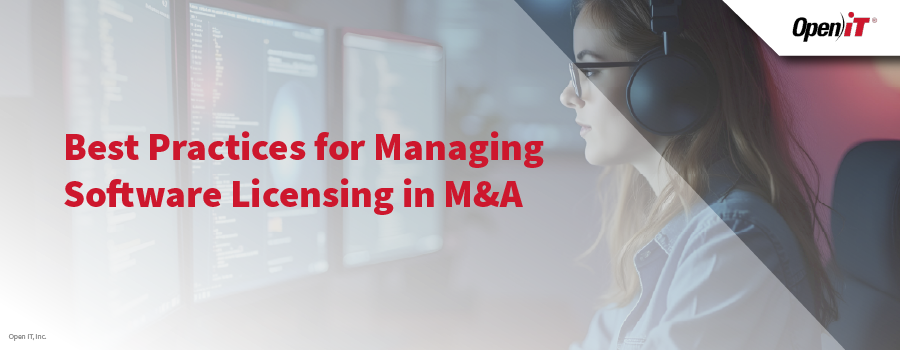M&A reshapes organizations, but without disciplined software asset management, it can also magnify risk and waste
Mergers and acquisitions (M&A) represent inflection points where organizations consolidate not only assets and people but also technology. Among the most underestimated complexities in this process is software licensing. Engineering and specialty applications—such as those from Autodesk, MathWorks, Dassault Systèmes, Siemens, PTC, Ansys, Bentley, and SAP—are mission-critical, high-value, and often licensed under terms that were never designed to account for the structural upheaval of an M&A.
For companies in engineering-intensive industries, failing to address software asset management (SAM) during M&A can lead to compliance risks, unnecessary costs, vendor disputes, and operational delays. Open iT brings decades of expertise in optimizing engineering and specialty software environments, offering proven strategies for navigating these high-stakes transitions with confidence.
CONNECT: Turn M&A Software Chaos Into Strategic Synergy
5 Key Challenges in Software Licensing During M&A
1. Contractual Restrictions and Transferability
Many engineering software licenses are non-transferable or tied to specific entities, sites, or geographies. For example, contracts may restrict usage to a single legal entity, meaning licenses from the acquired company cannot simply be “rolled over” into the parent organization. Without proactive review, businesses risk breaching terms or invalidating entitlements.
2. Overlapping and Redundant Agreements
When two organizations merge, it’s common to find duplicate contracts for the same vendor—such as two Autodesk enterprise agreements or multiple MathWorks toolboxes licensed under separate terms. Consolidation without visibility leads to redundant spend and missed opportunities for negotiation.
3. Compliance Risks and Vendor Audits
Engineering software vendors are known for rigorous audit practices during M&A activity. License transfers, expanded user bases, or usage across new geographies can all trigger reviews. Without clear visibility into usage data and entitlement positions, companies face heightened risk of audit penalties.
4. Data and Tool Fragmentation
Each organization may have different SAM tools, reporting processes, or metering systems. Reconciling these into a unified view is often one of the most time-consuming aspects of integration. A lack of reliable data undermines decision-making and delays consolidation efforts.
5. Cloud and Hybrid Licensing Complexities
With vendors like Dassault Systèmes, Siemens, and PTC shifting to subscription and cloud-based models, M&A events raise questions about how these subscriptions can be reassigned, merged, or terminated. Hybrid environments—where perpetual, subscription, and token-based models coexist—add further complexity. Cloud licensing introduces additional challenges for compliance and optimization.
7 Best Practices for Managing Software Licensing in M&A

1. Early SAM Involvement in Due Diligence
Software licensing must be treated as a core due diligence item, not an afterthought. Involving SAM experts from the outset allows for identification of contractual restrictions, compliance exposures, and optimization opportunities before integration begins. Open iT helps organizations gather entitlement data, usage reports, and vendor contracts early in the process, enabling informed decision-making.
2. Establish a Unified Inventory and Usage Baseline
The first step toward rationalization is to establish a comprehensive inventory of all licenses, entitlements, and usage across both organizations. Open iT’s advanced metering and reporting solutions provide granular insights—down to feature-level usage, idle time, and user activity—allowing teams to distinguish between critical licenses and redundant or underutilized ones.
3. Prioritize Compliance and Governance
During an M&A, compliance risks are magnified. Organizations should implement governance controls to ensure that licenses are used in accordance with vendor agreements. Open iT solutions enable real-time monitoring and historical reporting, ensuring that usage aligns with contractual terms and providing defensible data in the event of vendor audits.
4. Rationalize and Consolidate Vendor Agreements
With clear usage data, companies can strategically consolidate vendor agreements. For instance, instead of maintaining two overlapping Ansys or Autodesk contracts, organizations can negotiate a consolidated enterprise agreement with better terms. This approach not only reduces costs but also strengthens vendor negotiation positioning.
5. Optimize Utilization for Cost Efficiency
Beyond compliance, M&A presents an opportunity to optimize utilization across the new enterprise. By analyzing true demand, peak usage, and license efficiency, Open iT helps companies identify where to reallocate, reduce, or expand licenses. This ensures that the merged organization pays only for what it truly needs, while maintaining availability for critical users.
6. Plan for Cloud and Hybrid License Management
Subscription-based and token models introduce new considerations during integration. Organizations should proactively evaluate how cloud entitlements can be reassigned, pooled, or terminated across Autodesk, PTC, or Siemens environments. Open iT Analyzer for Cloud Licensing provides visibility into these models, ensuring seamless management across hybrid environments.
7. Proactive Vendor Engagement
Vendors often leverage M&A events as opportunities to push for audits, upgrades, or more restrictive terms. Armed with accurate usage and entitlement data, organizations can approach negotiations from a position of strength. Open iT equips businesses with defensible insights to engage vendors proactively, mitigating risks while securing favorable terms.

Open iT | Webinars On-Demand
License Consolidation Strategy During Mergers & Acquisitions
5 Strategic Outcomes of Effective SAM in M&A
When software licensing is managed strategically during M&A, organizations can realize:
1. Cost Synergies
Avoid redundant spend by consolidating overlapping contracts and optimizing license portfolios.
2. Operational Continuity
Ensure critical engineering applications remain available to users throughout the transition.
3. Risk Mitigation
Reduce exposure to audit penalties and contractual breaches through data-backed compliance management.
4. Stronger Negotiation Position
Leverage consolidated demand and accurate usage insights to negotiate better terms with vendors.
5. Long-Term Efficiency
Lay the foundation for an optimized, governance-driven SAM framework in the post-merger organization.
Software Licenses: Major Lever for M&A Success
M&A reshapes organizations, but without disciplined software asset management, it can also magnify risk and waste. Engineering and specialty applications are among the most expensive and business-critical assets on the books. Mismanaging them during integration doesn’t just lead to compliance exposures or redundant costs. It threatens productivity, delays innovation, and erodes the very synergies M&A is meant to create.
The organizations that succeed are those that treat SAM as a strategic pillar of M&A execution. By gaining deep visibility into entitlements and usage, enforcing governance, and optimizing portfolios, companies can turn licensing challenges into cost savings, operational resilience, and stronger vendor leverage.
Open iT delivers the clarity and control required at this critical juncture. With precision metering, advanced reporting, and optimization strategies purpose-built for engineering and specialty software, we ensure that software assets remain an enabler—not an obstacle—in the merger journey.
Don’t leave software licensing to chance in your next M&A. Contact Open iT today to schedule a readiness assessment and secure the full value of your software investments.
Talk to an Open iT Expert About Building a Unified, Compliant SAM Framework.






